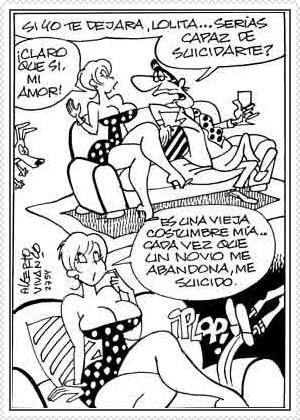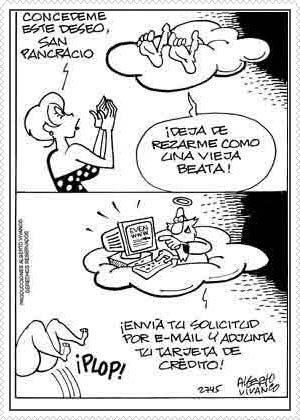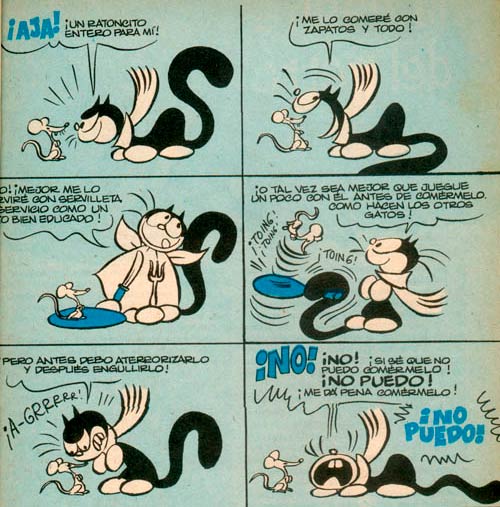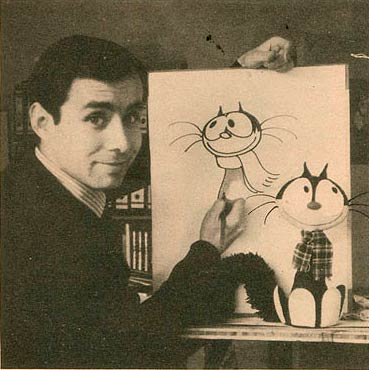'Lolita'.
Alberto Vivanco Ortiz is a Chilean cartoonist, who is best known for his drawings of sexy girls, most notably his cartoon character 'Lolita' (1960). His work has been published throughout South America, and he has also launched several magazines in his native country Chile.
Early life and career
He was born in 1939. At age 20, Vivanco left his home town Quilpué to study Journalism at the University of Chile in Santiago in early 1960. He had several proposals for cartoons and magazines with him to present to publishers in the country's capital. He got his first cartooning job with the Catholic weekly La Voz, where he replaced Hernán Vidal, the creator of 'Malaquías', during an illness. Vivanco also published some work in the children's magazine El Peneca of Editorial Zig-Zag, and was present in La Pandilla, a magazine based around the creations of Chilean writer Marcela Paz, with the story 'El Gordo Sotito'. While with this magazine, he befriended the comic artists Pepo and Abel Romero, as well as the journalist Carlos Alberto Cornejo. Vivanco also worked with Pepo on his classic 'Condorito' comic.
Lolita
He joined the daily Clarín, where he introduced his sexy cartoon character 'Lolita' in September 1960. Shortly afterwards, a color Sunday page was added to the daily feature. The character was deemed vulgar by some because it shared the same name and themes from the controversial 1955 novel by Russian writer Vladimir Nabokov. The paper's editor insisted on using the name, and after a few years "lolita" became a symbol for the country's transgressive youth, and, eventually, a Chilean nickname for pretty girls in general.
'Yo-Yó'.
Ritmo
One of the projects Vivanco had brought with him from Quilpué was Ritmo, a magazine aimed to reflect the growing role of adolescents and youth in Chilean society. The project was eventually picked up by the small publishing firm Lord Cochrane, and the first issue appeared on 9 September 1965. Vivanco served as deputy director, while Chilean performer and radio host María Pilar Larraín was appointed editor-in-chief. It was in this magazine that Vivanco introduced his cat 'Yo-Yó', while leaving 'Lolita' to Ricardo González for two years.
La Chiva
Vivanco continued to launch new publications in the following years. With his friends Hernán Vidal (Hervi), José Palomo and his brother Jorge Vivanco (Pepe Huinca), he formed the artistic team of the satirical magazine La Chiva in 1968.
Paloma
He furthermore launched the women's magazine Paloma, which sold 240,000 copies per issue in the 1970s.
El Pinguino
Between 1967 and 1969, Alberto and Jorge Vivanco were head of the erotic humor magazine El Pinguino, which published regular work by Hervi, Themo Lobos and Mateluna.
Later years
The aftermath of Chile's coup d'état of 1973 left Vivanco without a job, and he fled to Venezuela in July 1974. He managed to get his 'Lolita' character a spot in the daily newspaper Diario 2001 from Caracas, and later also other publications from Venezuela, Mexico and Colombia. He spent most of the 1970s and 1980s working as a commercial artist, while Chilean artists like Hervi, Jecho, Tom, Nestor Espinosa, Edmundo Pezoa and Pepe Huinca helped with the production of 'Lolita'. Vivanco returned to full time cartooning in the early 1990s and turned 'Lolita' into a syndicated comic strip.









